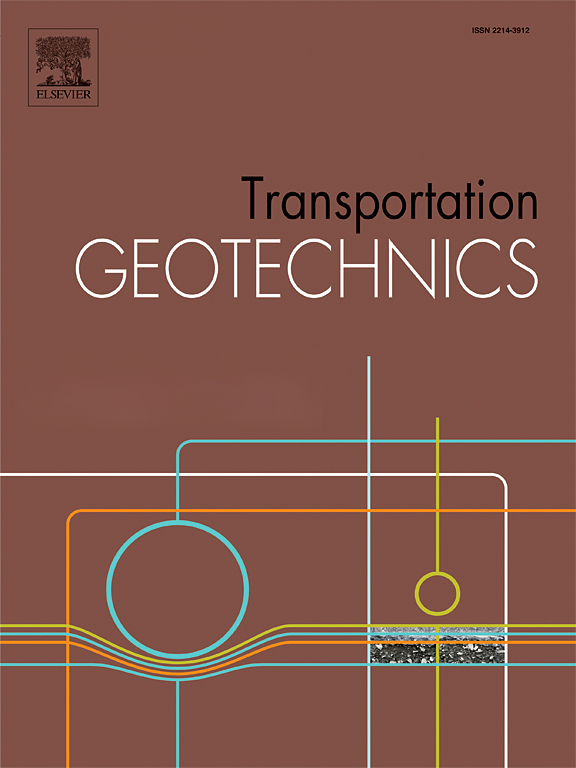The impact of Microbially Induced Calcite Precipitation (MICP) on sand internal erosion resistance: A microfluidic study
IF 4.9
2区 工程技术
Q1 ENGINEERING, CIVIL
引用次数: 0
Abstract
Fine particle internal erosion involves the detachment, transport, and deposition of fine particles within soil, significantly impacting agriculture, engineering, and environmental protection. Microbially induced calcite precipitation (MICP) has proven to be an effective method for controlling internal erosion. To optimize MICP protocols for effective erosion control, understanding the microscopic mechanisms by which MICP reduces fine particle erosion is essential but remains unclear. In this study, microfluidic chip experiments were conducted to observe the characteristics of calcium carbonate crystals and fine particles before and after MICP reinforcement and erosion. Through quantitative analysis of the calcium carbonate produced by MICP and eroded fine particles, the effects of bacterial density, concentration of cementation solution, and flow rate on the efficiency of MICP in resisting soil internal erosion were investigated. In addition, three primary mechanisms by which MICP reduces fine particle erosion were identified. Firstly, in situ sand stabilization occurs when calcium carbonate generated by MICP bonds and encapsulates fine particles, forming larger particles that remain stable under erosive flow conditions. Secondly, regional sand stabilization is achieved as MICP-produced calcium carbonate crystals narrow or block the flow channels, preventing extensive migration of fine particles. Lastly, adjacent particle stabilization is facilitated by calcium carbonate crystals, which remain stable during water flow erosion and alter the erosion flow lines, creating zones adjacent to the crystals where fine particle movement is minimized. These findings provide a deeper understanding of the role of MICP in erosion control and can inform the development of more effective erosion mitigation strategies.
微生物诱导方解石沉淀(MICP)对沙子内部抗侵蚀性的影响:微流控研究
细颗粒内侵蚀涉及土壤中细颗粒的剥离、迁移和沉积,对农业、工程和环境保护产生重大影响。事实证明,微生物诱导方解石沉淀(MICP)是控制内侵蚀的有效方法。为了优化 MICP 方案以有效控制侵蚀,了解 MICP 减少细颗粒侵蚀的微观机制至关重要,但目前仍不清楚。本研究通过微流控芯片实验观察了 MICP 加固和侵蚀前后碳酸钙晶体和细颗粒的特征。通过对 MICP 产生的碳酸钙和被侵蚀的细颗粒进行定量分析,研究了细菌密度、固结溶液浓度和流速对 MICP 抵抗土壤内部侵蚀效率的影响。此外,还确定了 MICP 减少细颗粒侵蚀的三个主要机制。首先,当 MICP 产生的碳酸钙粘合并包裹细颗粒,形成较大的颗粒并在侵蚀性流动条件下保持稳定时,就会发生原地固沙。其次,当 MICP 产生的碳酸钙晶体缩小或堵塞流道,阻止细颗粒的大范围迁移时,就实现了区域固沙。最后,碳酸钙晶体在水流侵蚀过程中保持稳定,并改变侵蚀流线,在晶体附近形成细颗粒移动最小的区域,从而促进了邻近颗粒的稳定。这些发现加深了人们对 MICP 在侵蚀控制中的作用的理解,可为制定更有效的侵蚀缓解战略提供参考。
本文章由计算机程序翻译,如有差异,请以英文原文为准。
求助全文
约1分钟内获得全文
求助全文
来源期刊

Transportation Geotechnics
Social Sciences-Transportation
CiteScore
8.10
自引率
11.30%
发文量
194
审稿时长
51 days
期刊介绍:
Transportation Geotechnics is a journal dedicated to publishing high-quality, theoretical, and applied papers that cover all facets of geotechnics for transportation infrastructure such as roads, highways, railways, underground railways, airfields, and waterways. The journal places a special emphasis on case studies that present original work relevant to the sustainable construction of transportation infrastructure. The scope of topics it addresses includes the geotechnical properties of geomaterials for sustainable and rational design and construction, the behavior of compacted and stabilized geomaterials, the use of geosynthetics and reinforcement in constructed layers and interlayers, ground improvement and slope stability for transportation infrastructures, compaction technology and management, maintenance technology, the impact of climate, embankments for highways and high-speed trains, transition zones, dredging, underwater geotechnics for infrastructure purposes, and the modeling of multi-layered structures and supporting ground under dynamic and repeated loads.
 求助内容:
求助内容: 应助结果提醒方式:
应助结果提醒方式:


